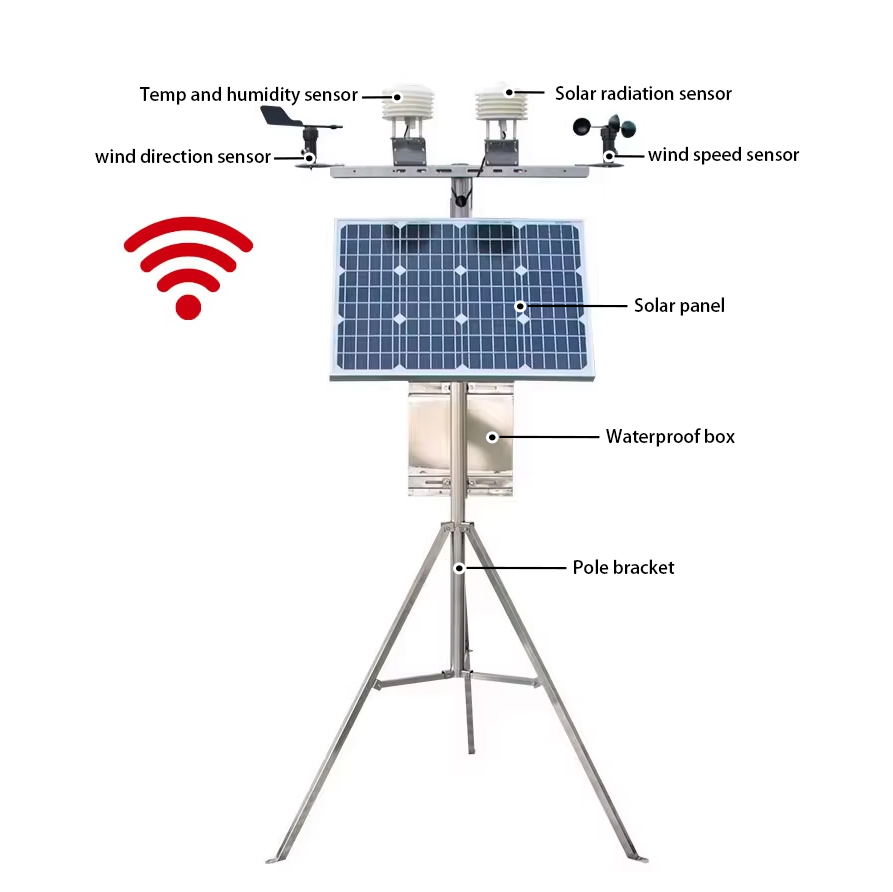สถานีอุตุนิยมวิทยาอัจฉริยะแห่งแรกในอเมริกาใต้เริ่มใช้งานอย่างเป็นทางการที่เทือกเขาแอนดีสในประเทศเปรู สถานีอุตุนิยมวิทยาสมัยใหม่แห่งนี้สร้างขึ้นร่วมกันโดยหลายประเทศในอเมริกาใต้ โดยมีเป้าหมายเพื่อเสริมสร้างขีดความสามารถในการวิจัยสภาพภูมิอากาศในภูมิภาค เสริมสร้างระบบเตือนภัยภัยพิบัติทางธรรมชาติ และให้การสนับสนุนข้อมูลอุตุนิยมวิทยาที่แม่นยำสำหรับสาขาสำคัญๆ เช่น เกษตรกรรม พลังงาน และการจัดการทรัพยากรน้ำ
จุดเด่นทางเทคนิคของสถานีตรวจอากาศอัจฉริยะ
สถานีอุตุนิยมวิทยาแห่งนี้ติดตั้งอุปกรณ์ตรวจวัดอุตุนิยมวิทยาที่ทันสมัยที่สุด ซึ่งรวมถึงเรดาร์ดอปเปลอร์ ไลดาร์ เครื่องรับสัญญาณดาวเทียมความละเอียดสูง และเซ็นเซอร์อุตุนิยมวิทยาภาคพื้นดิน อุปกรณ์เหล่านี้สามารถตรวจสอบพารามิเตอร์อุตุนิยมวิทยาต่างๆ ได้แบบเรียลไทม์ เช่น อุณหภูมิ ความชื้น ความกดอากาศ ความเร็วลม ทิศทางลม ปริมาณน้ำฝน และรังสีดวงอาทิตย์
เรดาร์ดอปเปลอร์: ใช้ในการติดตามความเข้มข้นของปริมาณน้ำฝนและเส้นทางการเคลื่อนตัวของพายุ และสามารถแจ้งเตือนภัยพิบัติ เช่น ฝนตกหนักและน้ำท่วมได้ล่วงหน้าหลายชั่วโมง
2. LIDAR: ใช้ในการวัดการกระจายตัวในแนวตั้งของละอองลอยและเมฆในชั้นบรรยากาศ โดยให้ข้อมูลสำคัญสำหรับการติดตามคุณภาพอากาศและการวิจัยการเปลี่ยนแปลงสภาพภูมิอากาศ
3. เครื่องรับสัญญาณดาวเทียมความละเอียดสูง: สามารถรับข้อมูลจากดาวเทียมอุตุนิยมวิทยาหลายดวง ช่วยวิเคราะห์สภาพอากาศและแนวโน้มต่างๆ ได้อย่างครอบคลุม
4. เซ็นเซอร์อุตุนิยมวิทยาภาคพื้นดิน: กระจายอยู่ในระดับความสูงและตำแหน่งต่างๆ ทั่วสถานีอุตุนิยมวิทยา เซ็นเซอร์เหล่านี้จะรวบรวมข้อมูลอุตุนิยมวิทยาภาคพื้นดินแบบเรียลไทม์เพื่อให้แน่ใจว่าข้อมูลมีความถูกต้องและครอบคลุม
ความร่วมมือระดับภูมิภาคและการแบ่งปันข้อมูล
สถานีตรวจอากาศอัจฉริยะแห่งนี้เกิดจากความร่วมมือระหว่างหลายประเทศในอเมริกาใต้ ได้แก่ เปรู ชิลี บราซิล อาร์เจนตินา และโคลอมเบีย ประเทศที่เข้าร่วมจะได้รับและแลกเปลี่ยนข้อมูลอุตุนิยมวิทยาแบบเรียลไทม์ผ่านแพลตฟอร์มข้อมูลที่ใช้ร่วมกัน แพลตฟอร์มนี้ไม่เพียงแต่ช่วยให้กรมอุตุนิยมวิทยาของประเทศต่างๆ ดำเนินการพยากรณ์อากาศและเตือนภัยภัยพิบัติได้ดียิ่งขึ้นเท่านั้น แต่ยังเป็นแหล่งทรัพยากรข้อมูลอันทรงคุณค่าสำหรับสถาบันวิจัยทางวิทยาศาสตร์ ส่งเสริมการวิจัยในสาขาต่างๆ เช่น การเปลี่ยนแปลงสภาพภูมิอากาศและการอนุรักษ์ระบบนิเวศ
เสริมสร้างศักยภาพการเตือนภัยล่วงหน้า
อเมริกาใต้เป็นภูมิภาคที่เกิดภัยพิบัติทางธรรมชาติบ่อยครั้ง ไม่ว่าจะเป็นแผ่นดินไหว น้ำท่วม ภัยแล้ง และภูเขาไฟระเบิด เป็นต้น การเปิดใช้งานสถานีตรวจอากาศอัจฉริยะจะช่วยเพิ่มศักยภาพในการเตือนภัยล่วงหน้าในภูมิภาคได้อย่างมาก ด้วยการตรวจสอบและวิเคราะห์ข้อมูลแบบเรียลไทม์ ผู้เชี่ยวชาญด้านอุตุนิยมวิทยาสามารถคาดการณ์เหตุการณ์สภาพอากาศรุนแรงได้อย่างแม่นยำยิ่งขึ้น และเผยแพร่ข้อมูลเตือนภัยล่วงหน้าแก่ประชาชนและรัฐบาลได้อย่างทันท่วงที ซึ่งจะช่วยลดความสูญเสียจากภัยพิบัติได้
ผลกระทบต่อการเกษตรและพลังงาน
ข้อมูลอุตุนิยมวิทยามีความสำคัญอย่างยิ่งยวดต่อภาคเกษตรกรรมและพลังงาน การพยากรณ์อากาศที่แม่นยำช่วยให้เกษตรกรสามารถบริหารจัดการกิจกรรมทางการเกษตรและเพิ่มผลผลิตพืชผลได้ดีขึ้น ขณะเดียวกัน ข้อมูลอุตุนิยมวิทยายังสามารถนำไปใช้เพื่อเพิ่มประสิทธิภาพการผลิตและการกระจายแหล่งพลังงานหมุนเวียน เช่น พลังงานแสงอาทิตย์และพลังงานลม การเปิดใช้งานสถานีตรวจอากาศอัจฉริยะจะช่วยสนับสนุนการพัฒนาภาคเกษตรกรรมและพลังงานในอเมริกาใต้ได้เป็นอย่างดี
แนวโน้มในอนาคต
ผู้อำนวยการสำนักอุตุนิยมวิทยาเปรูกล่าวในพิธีเปิดว่า “การเปิดสถานีตรวจอากาศอัจฉริยะนี้ถือเป็นก้าวใหม่แห่งภารกิจด้านอุตุนิยมวิทยาในอเมริกาใต้” เราหวังว่าแพลตฟอร์มนี้จะช่วยส่งเสริมความร่วมมือด้านอุตุนิยมวิทยาในระดับภูมิภาค เสริมสร้างศักยภาพในการเตือนภัยล่วงหน้า และสร้างพื้นฐานทางวิทยาศาสตร์สำหรับการรับมือกับการเปลี่ยนแปลงสภาพภูมิอากาศ
ในอนาคต ประเทศในอเมริกาใต้มีแผนที่จะขยายเครือข่ายการเฝ้าระวังอุตุนิยมวิทยาโดยใช้สถานีตรวจอากาศอัจฉริยะ โดยเพิ่มสถานีสังเกตการณ์และจุดรวบรวมข้อมูล ขณะเดียวกัน ทุกประเทศจะส่งเสริมการพัฒนาบุคลากรและการแลกเปลี่ยนเทคโนโลยีเพื่อส่งเสริมการพัฒนากิจการอุตุนิยมวิทยาในอเมริกาใต้ร่วมกัน
บทสรุป
การเปิดตัวสถานีตรวจอากาศอัจฉริยะแห่งแรกของอเมริกาใต้ไม่เพียงแต่ให้การสนับสนุนทางเทคนิคที่แข็งแกร่งสำหรับการวิจัยอุตุนิยมวิทยาระดับภูมิภาคและการเตือนภัยล่วงหน้าเท่านั้น แต่ยังเป็นการวางรากฐานที่แข็งแกร่งสำหรับความร่วมมือระหว่างประเทศต่างๆ ในด้านการเปลี่ยนแปลงสภาพภูมิอากาศและการพัฒนาอย่างยั่งยืน ด้วยความก้าวหน้าทางเทคโนโลยีอย่างต่อเนื่องและความร่วมมือที่ลึกซึ้งยิ่งขึ้น อุตสาหกรรมอุตุนิยมวิทยาในอเมริกาใต้จะก้าวสู่อนาคตที่สดใสยิ่งขึ้น
เวลาโพสต์: 24 เม.ย. 2568


